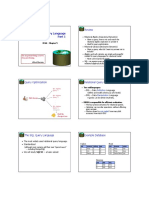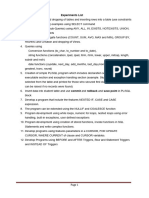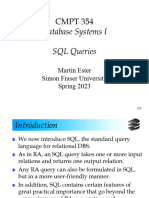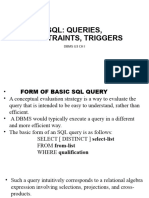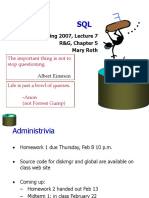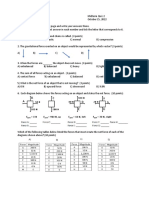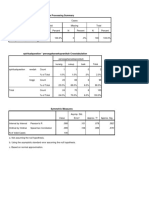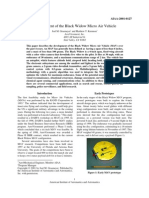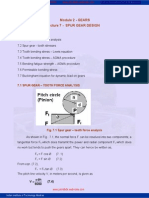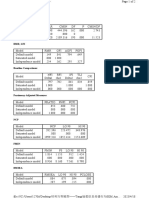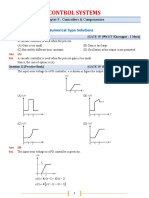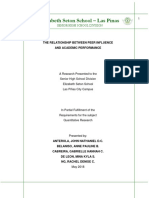SQL: The Query Language Part 1
R &G - Chapter 5
Life is just a bowl of queries. -Anon (not Forrest Gump)
�Relational Query Languages
Two sublanguages:
DDL Data Definition Language
Define and modify schema (at all 3 levels)
DML Data Manipulation Language
Queries can be written intuitively. DBMS is responsible for efficient evaluation. The key: precise semantics for relational queries. Optimizer can re-order operations, without affecting query answer. Choices driven by cost model
�The SQL Query Language
The most widely used relational query language. Standardized
(although most systems add their own special sauce -- including PostgreSQL)
We will study SQL92 -- a basic subset
�Example Database
Sailors
sid 1 2 3 sname Fred Jim Nancy rating 7 2 8 age 22 39 27
Boats
bid 101 102 103 bname Nina Pinta color red blue
Santa Maria red
Reserves
sid 1 2 bid 102 102 day 9/12 9/13
�The SQL DDL
CREATE TABLE Sailors (sid INTEGER, sname CHAR(20), rating INTEGER, age REAL, PRIMARY KEY sid) CREATE TABLE Boats (bid INTEGER, bname CHAR (20), color CHAR(10) PRIMARY KEY bid) CREATE TABLE Reserves (sid INTEGER, bid INTEGER, day DATE, PRIMARY KEY (sid, bid, date), FOREIGN KEY sid REFERENCES Sailors,
�The SQL DML
Sailors
sid 1 2 3 sname Fred Jim Nancy rating 7 2 8 age 22 39 27
Find all 18-year-old sailors: SELECT * FROM Sailors S WHERE S.age=18
To find just names and ratings, replace the first line:
SELECT S.sname, S.rating
�Querying Multiple Relations
SELECT S.sname FROM Sailors S, Reserves R WHERE S.sid=R.sid AND R.bid=102
Sailors
sid 1 2 3 sname Fred Jim Nancy rating 7 2 8 age 22 39 27
Reserves
sid 1 2 bid 102 102 day 9/12 9/13
�Basic SQL Query
SELECT
[DISTINCT]
target-list
FROM
relation-
list
relation-list : List of relation names qualification possibly with a range variable after each name target-list : List of attributes of tables in relation-list qualification : Comparisons combined using AND, OR and NOT. DISTINCT : optional keyword indicating that the answer should not contain duplicates.
WHERE
�Query Semantics
1. 2. 3. 4. FROM : compute cross product of tables. WHERE : Check conditions, discard tuples that fail. SELECT : Delete unwanted fields. DISTINCT (optional) : eliminate duplicate rows.
Note: Probably the least efficient way to compute a query! Query optimizer will find more efficient ways to get the same answer.
�Find sailors whove reserved at least one boat
SELECT S.sid FROM Sailors S, Reserves R WHERE S.sid=R.sid Would adding DISTINCT to this query make a difference? What is the effect of replacing S.sid by S.sname in the SELECT clause?
Would adding DISTINCT to this variant of the query make a difference?
�About Range Variables
Needed when ambiguity could arise.
e.g., same table used multiple times in FROM (self-join)
SELECT x.sname, x.age, y.sname, y.age FROM Sailors x, Sailors y WHERE x.age > y.age
Sailors
sid 1 2 3 sname Fred Jim Nancy rating 7 2 8 age 22 39 27
�Arithmetic Expressions
SELECT S.age, S.age-5 AS age1, 2*S.age AS age2 FROM Sailors S WHERE S.sname = dustin
SELECT S1.sname AS name1, S2.sname AS name2 FROM Sailors S1, Sailors S2 WHERE 2*S1.rating = S2.rating - 1
�String Comparisons
SELECT S.sname FROM Sailors S WHERE S.sname LIKE B_%B
`_ stands for any one character and `% stands for 0 or more arbitrary characters.
�Find sids of sailors whove reserved a red or a green boat SELECT R.sid FROM Boats B, Reserves R WHERE R.bid=B.bid AND (B.color=red OR B.color=green)
... or:
SELECT R.sid FROM Boats B, Reserves R WHERE R.bid=B.bid AND B.color=red UNION SELECT R.sid FROM Boats B, Reserves R WHERE R.bid=B.bid AND
�Find sids of sailors whove reserved a red and a green boat
SELECT R.sid FROM Boats B,Reserves R WHERE R.bid=B.bid AND (B.color=red AND B.color=green)
�Find sids of sailors whove reserved a red and a green boat
SELECT S.sid FROM Sailors S, Boats B, Reserves R WHERE S.sid=R.sid AND R.bid=B.bid AND B.color=red INTERSECT SELECT S.sid FROM Sailors S, Boats B, Reserves R WHERE S.sid=R.sid AND R.bid=B.bid AND B.color=green
�Find sids of sailors whove reserved a red and a green boat
Could use a self-join:
SELECT R1.sid FROM Boats B1, Reserves R1, Boats B2, Reserves R2 WHERE R1.sid=R2.sid AND R1.bid=B1.bid AND R2.bid=B2.bid AND (B1.color=red AND B2.color=gre
�Find sids of sailors who have not reserved a boat
SELECT S.sid FROM Sailors S EXCEPT SELECT S.sid FROM Sailors S, Reserves R WHERE S.sid=R.sid
�Nested Queries: IN
mes of sailors whove reserved boat #103:
SELECT S.sname FROM Sailors S WHERE S.sid IN (SELECT WHERE
R.sid FROM R.bid=103) Reserves R
�Nested Queries: NOT IN
s of sailors whove not reserved boat #103:
LECT S.sname FROM Sailors S ERE S.sid NOT IN (SELECT
R.sid FROM R.bid=103)
Reserv
WHERE
�Nested Queries with Correlation
mes of sailors whove reserved boat #103:
SELECT S.sname FROM Sailors S WHERE EXISTS (SELECT * FROM Reserves R WHERE R.bid=103 AND S.sid=R.sid) Subquery must be recomputed for each Sailors tuple. Think of subquery as a function call that runs a query! Also: NOT EXISTS.
�UNIQUE
of sailors whove reserved boat #103 exactly
SELECT S.sname FROM Sailors S WHERE UNIQUE (SELECT * FROM Reserves R WHERE R.bid=103 AND S.sid=R.sid)
�More on Set-Comparison Operators
weve seen: IN, EXISTS, UNIQUE can also have: NOT IN, NOT EXISTS, NOT UNIQUE other forms: op ANY, op ALL Find sailors whose rating is greater than that of some sailor called Horatio: SELECT * FROM Sailors S WHERE S.rating > ANY (SELECT S2.rating FROM Sailors S2 WHERE S2.sname=Horatio)
�A Tough One
nd sailors whove reserved all boats.
Sailors S such that ... B.bid
there is no boat B FROM Boats B without ... WHERE NOT EXISTS (SELECT R.bid a Reserves tuple showing S reserved B
�Summary
Relational model has well-defined query semantics SQL provides functionality close to basic relational model (some differences in duplicate handling, null values, set operators, ) Typically, many ways to write a query DBMS figures out a fast way to execute a query, regardless of how it is written.
